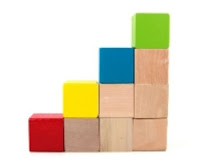MAPS by Aleksandra Mizielińska and Daniel Mizieliński, 112 pp, all ages
Big Picture Press's inaugural line of books features TWO titles from Aleksandra Mizielińska and Daniel Mizieliński - Welcome to Mamoko and MAPS! With their fantastic illustration style and eye for detail, MAPS is the perfect way to get the youngest readers interested in geography and the people and cultures of the world. Organized by continent, each featured nation gets its own spread. Less than 50 countries are featured, but each one is a delight to explore. A key on each page provides the flag of the featured country, the language spoken, population and area, which is helpful because every country is presented in roughly the same scale, meaning that Russia gets the same page space as the United Kingdom, although Greece only takes up half the page, the other half featuring the many significant details of the country.
The book begins with a table of contents that is a map of the world with lines and page numbers indicating the countries and continents featured. You can't tell from any of the images here, but the pages of MAPS look like the yellowed, cracked pages of an antique atlas. Each section begins with a map of the continent that labels the countries and their capitols and indicates the population and the size of the continent itself and the seas around the continent are filled with the local fish and their names.
 The Mizielińskis feature the expected, like geographical features and man made features (such as the location of the world's biggest snow castle in Finland) within the boundaries of featured countries. The edges of the pages are filled with fascinating things like names and illustrations of the flora and fauna native to the country, specialty foods, sports, past times, famous citizens, traditions and historical moments. Every country also features an illustration of a boy and a girl, labeled with names that reflect contemporary children's monikers. The American children are Mary, Jim and Emily, the Brits are Olivia and Jack. This may sound like an overwhelming amount of information to illustrate and add to each spread, but the Mizielinskis handle it all remarkably well. Pages look full, but never cluttered, and never overwhelming. MAPS is wonderful for quiet exploration, but it could also be a resource for a school report for lower grades as well and, above all else, a great conversation starter. Like all of the books from Big Picture Press's, MAPS would make a superb gift that kids and adults will love.
The Mizielińskis feature the expected, like geographical features and man made features (such as the location of the world's biggest snow castle in Finland) within the boundaries of featured countries. The edges of the pages are filled with fascinating things like names and illustrations of the flora and fauna native to the country, specialty foods, sports, past times, famous citizens, traditions and historical moments. Every country also features an illustration of a boy and a girl, labeled with names that reflect contemporary children's monikers. The American children are Mary, Jim and Emily, the Brits are Olivia and Jack. This may sound like an overwhelming amount of information to illustrate and add to each spread, but the Mizielinskis handle it all remarkably well. Pages look full, but never cluttered, and never overwhelming. MAPS is wonderful for quiet exploration, but it could also be a resource for a school report for lower grades as well and, above all else, a great conversation starter. Like all of the books from Big Picture Press's, MAPS would make a superb gift that kids and adults will love.
Source: Review Copy
If you loved MAPS, don't miss my all-time favorite non-fiction book for kids:
by Peter Menzel and Faith D'Aluisio

What the World Eats is the kid's version of Hungry Planet by the same authors, and is even better in my opinion, for the cool charts and graphs that they have added to this version. The authors traveled the world and asked families to purchase one week's worth of groceries and be photographed with it.
Visually stunning, What the World Eats is sure to be thought provoking and start conversations with even the youngest readers. And what a better way to get to know the people of the world by taking a look at what they eat each week? The text adds to the images, informing readers of the everything from the availability of potable water to the number of McDonald's restaurants in a country to the amount of meat eaten by citizens.











